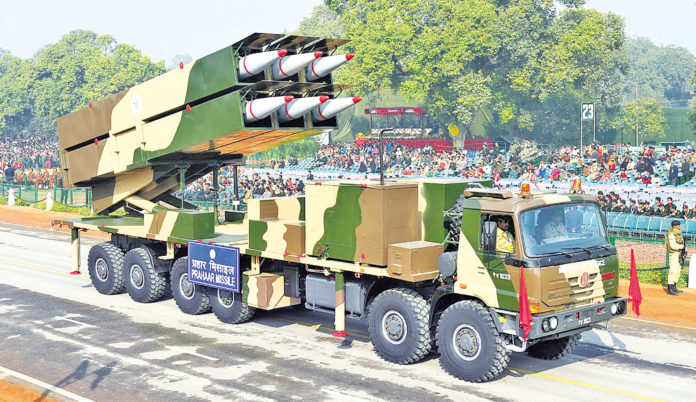5,000-km Range Submarine-launched Ballistic Missile Planned
The Defence Research and Development Organisation (DRDO) is focusing on a 5,000km-range ballistic missile to join the elite club of US, Russia and Chinese nuclear submarines.
With the K-4 submarine-launched ballistic missile completing the development stage and ready for induction, the DRDO has gone back to the drawing board to develop a 5,000km-range submarine-launched platform that matches the surface-to-surface Agni-V missile.
The 5,000km-range submarine-launched ballistic missile will carry the same K-series label and will cover all of Asia, parts of Africa, Europe and Indo-Pacific including South China Sea.
Details are classified, but after testing the 3,500km-range K-4 missile twice in one week, the weapon is now fully developed with fixed parameters and is ready to be inducted on INS Arihant class of nuclear submarines. The solid fuelled K-4 is a three-metre tall missile with accuracy within 100 metres of its over one tonne nuclear warhead. Both the tests were conducted using underwater pontoon off the coast of Vizag on India’s eastern seaboard. At present, INS Arihant carries B-05 nuclear missile with a range of 750km, with the K-15 nomenclature being made redundant.
New 200-km Range Tactical Ballistic Missile
India is working on a new tactical ballistic missile capable of striking targets at a range of 200km.
The surface-to-surface missile, being developed by the DRDO, has been named Pranash. The new weapon traces its origin to the Prahaar missile developed by the DRDO. Prahaar has a range of 150km but the army wanted a weapon with a better range, which is why Pranash is being developed.
The configuration of Pranash has been frozen and development trials will begin by 2021-end. DRDO will be in a position to offer it for user trials in two years. The non-nuclear Pranash missile will be propelled by a single-stage solid propellant engine.
DRDO’s short-range Prithvi series of missiles with ranges of 150 to 350 km are nuclear-capable and powered by a liquid propellant engine that has its limitations. Missiles with solid propellant engine are ready-to-use. However, liquid propellant engines can be complicated as the liquid propellant mixture has to be added before the launch.
India’s Agni series of nuclear-capable ballistic missiles can hit targets at different ranges between 700km and 5,500km.
Once developed, the Pranash missile could also be exported to friendly foreign countries. It will be one of the cheapest missiles in the world in its range category. Also, the missile is outside the purview of the Missile Technology Control Regime (MTCR), which places export restrictions on missiles with ranges of more than 300km.
500km BrahMos to be Tested
A next variant of BrahMos is expected to be tested by year-end. It will have a range of 500 km, 200 more than the existing range of 300 km and its precision strike ability will be fine-tuned to hit within 1 m of designated target. It will have better sensors and tracking devices which are now available after research.
The test will be of the land attack version which can be launched from land to another land target. Such a weapon – land-to-land attack – has been inducted into the Army albeit with a range of 300 km.
The range of the BrahMos can be increased after India becomes a part of the elite Missile Technology Control Regime (MTCR). The MTCR hinders the transfer of technology for missiles more than 300 km.
So far, three BrahMos missile regiments have been deployed in the western sector to counter threats from Pakistan. And fourth regiment is tasked in Arunachal Pradesh.
New Explosive Detection Device Developed
RaIDer-X, a new explosive detection device, was unveiled at the National Workshop on Explosive Detection (NWED-2020) in Pune today. RaIDer-X has the capability to detect explosives from a stand-off distance. The data library can be built in the system to expand its capability to detect a number of explosives in pure form as well as with the contaminants. Bulk explosive in concealed condition can also be detected by the device. RaIDer-X has been co-developed by High Energy Materials Research Laboratory (HEMRL) Pune and Indian Institute of Science, Bangalore.
In his address, Dr G Satheesh Reddy, Secretary, Department of Defence Research & Development and Chairman DRDO emphasised that detection of explosives was a compelling need of the hour. He said, security agencies were continuously monitoring vulnerable targets with the help of intelligence agencies to thwart the attempts of anti-social elements. Dr Reddy appreciated the joint pursuit of academia and DRDO in developing portable devices, which can now be safely and effectively used by security agencies.



















